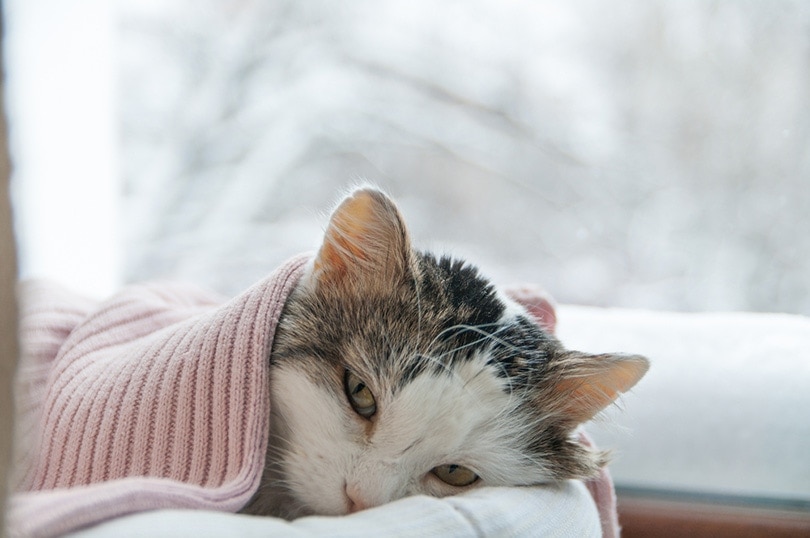How to Tell if a Cat Has Internal Bleeding (Vet Answer)
By Dr. Kim Podlecki, DVM (Vet)
Updated on

Internal bleeding in a cat can occur for a variety of reasons. How sick a cat will become completely depends on the cause of the bleeding. Potential causes of internal bleeding varies greatly from intestinal parasites to certain types of cancer. The cause will also determine how you may be able to tell at home if your cat is bleeding internally. In this article we’ll discuss what some of the most common reasons are for internal bleeding, what the abnormal signs can look like, and when you should take your cat to see a veterinarian.
Reason #1: Intestinal Parasites

Intestinal parasites are one of the most common causes of internal bleeding, especially in kittens and/or outdoor cats. If a cat is infected with a parasite, the parasites may cause bleeding within the intestinal tract. One of the most common parasites to cause this is the hookworm, although other bugs can also cause intestinal bleeding.
Cats become infected with hookworms by ingesting another animals feces infected with hookworms or by walking through infected soil, litter, or water. Sounds gross, I know! But considering that many cats share a common toilet (the litter box), it makes it easier to understand why they may get worms. Kittens can also contract hookworms through their mother’s milk.
How to Tell if Your Cat Has Intestinal Parasites
A cat infected with intestinal parasites may show no abnormal signs, and the parasite eggs are just seen on a fecal exam completed by your veterinarian. Other cats may have diarrhea, bloody diarrhea, or even black diarrhea. The black diarrhea is a sign that the cat has upper intestinal tract bleeding. Cats may also get a pot-bellied or bloated abdomen, or have vomiting or weight loss. If your cat has any of the abnormal signs, is lethargic, weak, and/or may be at high risk for parasites, please have them scheduled to see your veterinarian for evaluation.
How do you know if your cat has intestinal parasites? Your cat should go to their regular veterinarian at least once a year for an annual exam. At that exam, a fecal test should be completed, which can diagnose the parasites. This is especially important in multi-cat households who share litterboxes or indoor/outdoor cats. If your cat is not on any heartworm prevention, they may be more susceptible to intestinal parasites as well, as many prescribed preventatives also have anti-parasitic medications in them. Please speak with your regular veterinarian about getting them on appropriate prevention to keep them safe and healthy.
Typically, most parasites are not a concern for an emergency. If you suspect your cat may have bleeding from a parasite, contact your vet for an appointment and show up with a poop sample!
Reason #2: Toxin Ingestion

Any time an animal gets sick, owners often assume the worse. They assume their pet may have gotten into “poison.” While this is not the case most often, there are a few toxins that can cause internal bleeding in cats.
One of the more common toxins that can cause internal bleeding is rodenticide or rat bait, more specifically, the anti-coagulant rodenticides. Because cats are acrobats and can squeeze themselves into small spaces, they will often find rodenticide that owners thought were well out of reach. Cats will eat the poison (made to be tasty for rats to be attracted to it), and once they start to bleed will pass away unless appropriately treated. Signs of toxicity may include weakness, lethargy, heavy breathing, pale gums, bleeding from the eyes, nose or rectum, black colored stool, vomiting, or coughing up blood.
Other common toxins that can cause internal bleeding are human medications. If you or anyone in the house are taking blood-thinner medications, please make sure these are kept in a locked drawer or cabinet. Even a single pill can be deadly for a cat depending on the medication.
How to Tell if Your Cat Has Toxic Ingestion
If you think that your cat may have ingested any type of toxin, your best resource is the ASPCA Poison Control Center. Their website has a great database of toxic plants, foods, and common household products. You can also call their phone number and speak with a veterinary toxicologist to determine if the item and/or amount ingested is toxic to your cat.
Reason #3: Cancer

Unfortunately, one of the more difficult causes of internal bleeding to treat is cancer. Cats are masters of disguise. They will hide underlying illness for weeks or even months before owners even know they are sick. Often, cancers don’t show themselves on routine bloodwork. Cats may still be eating and drinking and otherwise acting themselves, and often times, more advanced testing is needed to find abnormalities. This is often a reason why cancer sometimes isn’t found until an animal has internal hemorrhage and become severely sick.
How to Tell if Your Cat Has Cancer
Cats may be normal one day and then the next day collapse, have heavy breathing, a distended abdomen, pale gums, or lethargy. Cancers that start to bleed have often been growing internally for weeks to months, but owners are unaware until the tumor bursts and bleeding occurs.
Treatment varies greatly depending on the condition of the cat and type of cancer found. However, if you have a middle aged to older cat with any of the above signs, we recommend you speak with your veterinarian immediately.
Reason #4: Trauma

Just like people, cats, especially ones kept outdoors, can be susceptible to trauma. In veterinary medicine, we can commonly see cats who are unfortunately hit by a car, fall from a porch or roof, or get attacked by another animal. In these cases, cats can be especially susceptible to internal bleeding.
As discussed with cancer, common signs of internal bleeding from trauma can include heavy breathing, open mouth breathing, pale or muddy colored gums, a distended abdomen, or bleeding from the face or rectum. After trauma, cats may also suffer hemorrhage around or behind their eyes.
How to Tell if Your Cat Has Experienced Trauma
Visible wounds caused by trauma, especially animal attacks, may have more serious internal wounds not visible to the eye. After any sort of trauma, whether you suspect internal bleeding or not, we recommend getting your cat to your local emergency veterinarian as soon as possible.
Conclusion
Signs of internal bleeding in cats tend to include pale or muddy gums, difficulty breathing, heavy breathing, a distended abdomen, lethargy, weakness, collapse, and visibly bleeding wounds. Internal bleeding can be caused by a number of reasons, some of the most common discussed above, such as parasites, trauma, and cancer. Depending on how sick the cat is, treatment will vary greatly. If you are concerned your cat may have internal bleeding from any cause, please contact your veterinarian.
- You may also be interested in: Cat Acupuncture: Benefits and Effectiveness (Vet Answer)
Featured Image Credit: Anna Nikonorova, Shutterstock















